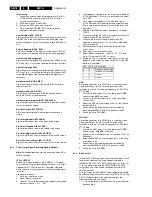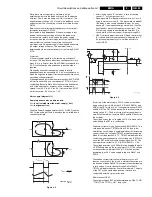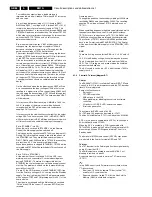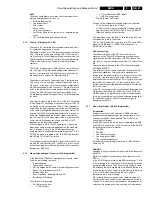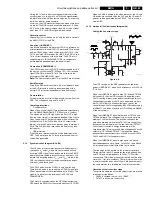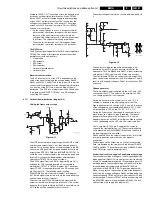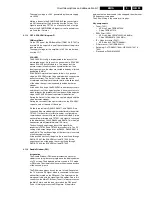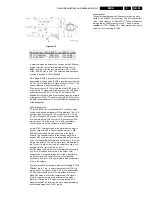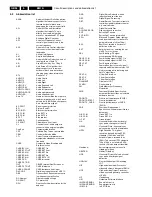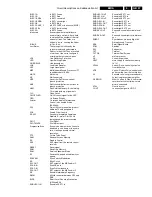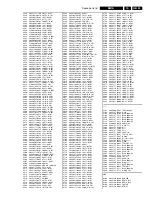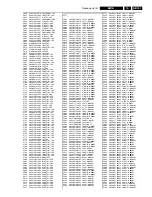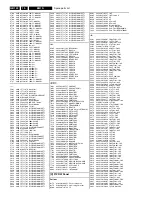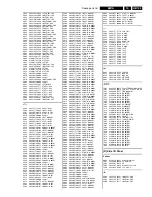
Circuit descriptions and abbreviation list
GB 92
EM1A
9.
Via the circuit built around TS7641 the frame output stage is
guarded. If the frame output stage is working properly,
TS7641 and TS7652 will both conduct and thereby
discharging C2642. TS7407 is blocked now, causing the
STANDBY signal to be high ohmic.
If there are frame pulses missing, TS7641 will block and
capacitor C2642 can be charged. Transistor TS7407 will now
start conducting and the STANDBY signal will be grounded
via R3403. This will switch off the main supply (see diagram
A1).
9.1.12 Audio (diagram B6, A5 & A6)
Introduction
All EM1A sets contain one of ITT's Multistandard Sound
Processing IC's for sound decoding. The diversity arises
because each member of the MSP-family handles its own set
of sound standards:
•
MSP3415D:
Europe & AP decoding, Stereo incl.
NICAM.
•
MSP3451G:
Global decoding, Virtual Dolby.
This IC takes care of the main FM sound decoding. AM
decoding for the L system is done by the HIP. The
demodulated L sound is then again source selected and
processed in the MSP. The reason for this is the bad AM
detection performance of the MSP. In case of NICAM L
however, this is handled by the MSP.
All MSP versions contain digital audio processing, used for
the basic left/right stereo sound, such as bass, treble,
balance, incredible sound and spatial. In addition to that, the
MSP3451 is also able to perform Virtual Dolby, a Dolby
approved sound mode for surround sound reproduction with
left/right speakers only.
Audio source selection
MSP3515D (stereo)
This IC is an economised version of the MSP3410 that is
used in the MG-chassis. It can cover 2 stereo and 1 mono
(AM) input. Since more inputs are required, a separate
source selector is used (HEF4052, IC7675). This selector
has AV1, AV2, FRONT and MON-OUT (Tuner) as input and
is connected to the EXT1 input of the MSP3415. The EXT2
input is not used.
Since the MSP3415 has only one EXT output, which is
connected to the EXT1, a constant level output and
connection to EXT2 is not available. This is fixed by
connecting the HEF4052 input selector to the constant level
output and to EXT2 via a so-called 'Régimbeau' switch
(IC7652).
This switch is needed to prevent feedback (Larsen effect).
When EXT2 is chosen as input signal, and the output of
EXT2 is selected, this means that the main picture is also
EXT2 and will cause the Larsen effect. To prevent this, the
record select must be switched to Tuner. This is especially
important when decoders are used, behind a 'transparent'
VCR connected to EXT2.
To get a constant level output if the Tuner is selected, the
EXT1 output (Tuner at any time), has to be fed back to the
input selector and selected as input for the MSP (EXT1
input).
The MSP3415 has no separate output to drive a headphone.
The headphone is therefore hardwired (on the LSP) to the
main sound output.
MSP3451G (Virtual Dolby)
The MSP3451, which is used in all versions supporting
Virtual Dolby, is capable of supporting 4 stereo inputs and 1
mono (AM) INPUT. Therefore the extra input selector
(HEF4052) is not needed.
The MSP3451 is also capable of supporting 2 EXT outputs,
so the trick used in the MSP3415 set-up to get a constant
level output is not needed.
The MSP3451 has a separate headphone output, so sound
control be done separate from the speakers.
Audio decoding
At the input a choice can be made between two IF-signals;
SIF and SIFM.
The selected signal is fed to the AGC. After this, an ADC
converts the IF-signal to digital.
This digital signal can be processed by 2 demodulation
channels. The first one is able to handle FM and NICAM
signals. The second one can handle FM and AM signals.
Each channel contains a mixer to shift the incoming signal in
the frequency domain. This shift is determined by the value
of a DCO (Digital Controlled Oscillator)..
After the down-mix, the signal is fed, via a filter, to a
discriminator. From here the AM, FM or NICAM
demodulation can be performed.
Both channels contain an 'automatic carrier mute' function,
which automatically mutes the output of the analogue section
when no carrier is detected.
After demodulation, the FM-signals are subjected to a de-
emphasis operation. After that the matrix of the stereo
system is applied.
Audio processing
The sound processing in EM1A is completely done by the
MSP3415D for 'Stereo' sets and the MSP3451G for 'Virtual
Dolby' sets:
•
Volume control is done by the user via the SOUND
menu.
•
Tone control is done via the BASS/TREBLE control.
•
Headphone control in 'Stereo'-sets is done via the
loudspeaker output of the MSP, no sound control
possible. In 'Virtual Dolby'-sets, the MSP has a separate
Headphone output so separate sound control is possible.
•
Mute control can be done in different ways:
–
Via the SOUND_ENABLE line of the Painter. Used
during start-up/switch-off conditions, in order to avoid
audible plops. This line is active low (high = mute).
–
Via the decoding part of the MSP.
–
Via the processing part of the MSP.
The mute on the RC or in the UI is per today a combination
of processing mute and SOUND_ENABLE line. When a user
mute is done, the processing mute will turn down the volume,
after which the SOUND_ENABLE line is switched. De-muting
is the other way around. The reason for this is a technical
problem with crosstalk of the headphone into the
loudspeakers.
Automatic Volume Levelling (AVL)
One of the features of the MSP-family is AVL. If used, it limits
the big volume differences in the broadcast between e.g.
news transmissions and commercials or within a movie.
To be able to get a Dolby approval (for the Virtual Dolby sets),
the AVL feature must be switchable. Therefore, the AVL
feature is customer switchable via the menu.
Audio amplification
The audio amplifier part is very straightforward. It uses 2
integrated power amplifier ICs (TDA2616). It delivers an
output of 2 x 10 WRMS to 2 full range speakers and/or
subwoofer.

